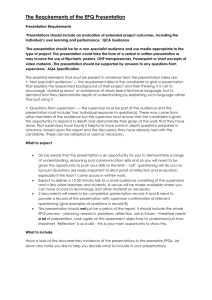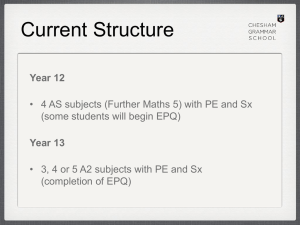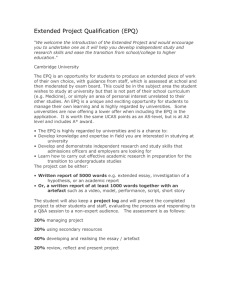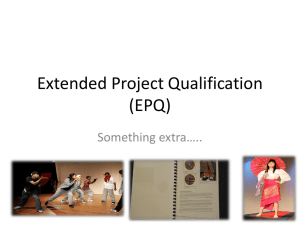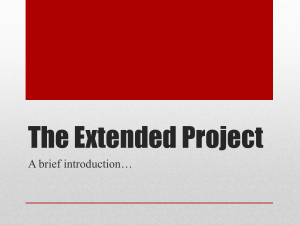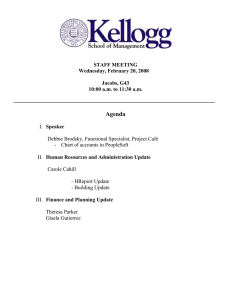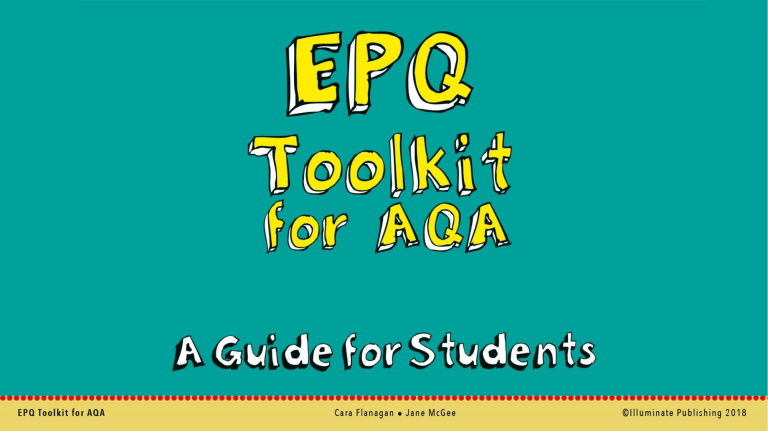
Lesson 1
Introducing the EPQ
Lesson 1 Introducing the EPQ
INTRODUCING THE EPQ
What is the EPQ?
• The Extended Project Qualification.
• Equivalent to half of an A-level.
• Part of Advanced Diploma or Baccalaureate.
• Taken alongside an A-level or BTEC programme.
Value of the EPQ?
• Independent work.
• Self-guided.
1/4 Book page 4
Lesson 1 Introducing the EPQ
THE BENEFITS OF THE EPQ
• Working with others.
• Working to deadlines.
• Planning and management of a project.
• Decision making and problem solving.
• Presentation skills.
• Communication skills.
Plus:
• Learn skills for University-level study.
• Achieve UCAS points without sitting an exam.
2/4 Book page 4
See exercise 0.1
Lesson 1 Introducing the EPQ
EPQ AT A GLANCE
Individual or group?
• Individual submission.
Format?
• Written report, essay, artefact, play …
Topic?
• Cannot be directly related to your studies (dual accreditation).
Taught element (30 hours) and independent work (90 hours).
3/4 Book page 5
Lesson 1 Introducing the EPQ
EPQ IN MORE DETAIL
4/4 Book pages 6–7
AO1 Manage the project: Clear aims and objectives, evidence of planning.
AO2 Use resources: Well-focused research.
AO3 Develop and realise: Autonomy, clear plan, well-written report, evidence of the journey.
AO4 Review: Reflecting on what you have learned.
Material that is assessed:
Your supervisor helps you through your project and marks the final version.
• PRODUCTION LOG.
• Written REPORT.
• Record of the PRESENTATION.
The centre coordinator oversees the whole process.
See exercise 0.2
An external moderator checks the marks given by your supervisor.
Lesson 2
Ideas for a topic title
Lesson 2 Ideas for a topic title
THE TAUGHT ELEMENT
EPQ takes about 120 hours, taught element = 30 hours:
• Safety skills.
• ICT skills.
• Research skills.
• Project management skills.
• Personal, learning, thinking skills.
• Sub-specific skills.
See suggested scheme of work on page 11.
1/3 Book pages 10–11
Lesson 2 Ideas for a topic title
PROJECT IDEAS FROM THE PAST
2/3 Book pages 12–13
• Extending your studies.
• An artefact.
• A newspaper article or TV programme.
• Doing own research on a topic you’d like to study at University.
• A performance.
• Cross-curricular topic.
Examples of good evaluative titles
Should the care of those suffering with Alzheimer’s disease be the responsibility of government?
How to raise a thousand pounds for a local charity.
Can I design and make a platform shoe in the style of the 1970s?
See exercise 1.2
Lesson 2 Ideas for a topic title
THINGS TO AVOID
• Overly ambitious topics.
• Emotive issues.
• Where you have a personal axe to grind.
• Socially sensitive topics.
• Dual accreditation.
• Don’t try to be too original.
• Avoid being too narrow or too broad.
3/3 Book pages 14–15
See exercise 1.3
Lesson 3
A preliminary literature review
Lesson 3 A preliminary literature review
DRILLING DOWN
A literature review = a systematic consideration of what other people have written or said about your chosen topic.
Literature = books, magazines, websites, TV programmes …
Use this preliminary literature review later when completing the
PART A: CANDIDATE PROPOSAL form.
Example:
1/2 Book page 16
Lesson 3 A preliminary literature review
A FLOWCHART
FOR DOING YOUR
PRELIMINARY
LITERATURE
REVIEW
2/2 Book pages 16–17
See exercise 1.4
Lesson 4
Writing the CANDIDATE PROPOSAL
Lesson 4 Writing the CANDIDATE PROPOSAL
THE PRE-PROJECT PROPOSAL FORM
You have now:
• Completed some preliminary research.
• Selected a topic.
Time to formally propose your project so it can be approved.
• WHO is affected by the topic?
• WHAT are the major questions for this topic?
• WHERE is your topic important?
• WHEN is your topic important?
Felix, who did the EPQ on Fracking.
1/5 Book page 18
See exercise 1.5
Lesson 4 Writing the CANDIDATE PROPOSAL 2/5
CONSTRUCTING THE RECORD OF INITIAL IDEAS
Book pages 19–20
The RECORD OF INITIAL IDEAS (page 5 of the EPQ candidate record).
STEP 1: Fill in the first two elements.
STEP 2: Discuss your ideas with your supervisor.
STEP 3: Record your supervisor’s comments on the form.
STEP 4: Modify your ideas and record your changes.
Lesson 4 Writing the CANDIDATE PROPOSAL 3/5
CONSTRUCTING PART A: CANDIDATE PROPOSAL
Book page 21
STEP 5:
PART A: CANDIDATE PROPOSAL (page 6 of the EPQ candidate record).
Beforehand: arrange an interim meeting with supervisor.
PART B: SUPERVISOR’S COMMENTS ON CANDIDATE PROPOSAL filled in by supervisor (page 7).
PART C: CENTRE COORDINATOR’S APPROVAL OF CANDIDATE PROPOSAL filled in by centre coordinator (page 8).
See next slide for copies of forms.
Harriet did an EPQ on the Olympics.
Lesson 4 Writing the CANDIDATE PROPOSAL 4/5 Book page 21
Lesson 4 Writing the CANDIDATE PROPOSAL
THE ROLE OF YOUR SUPERVISOR
5/5
DO set ground rules.
DO take responsibility.
DO use the support effectively.
DON’T go it alone.
DON’T let your supervisor be too directive.
DON’T be disorganised.
YOU arrange the meetings.
Make checklist of what has to be done with supervisor.
Record supervisor’s comments.
Book pages 22_23
See exercise 1.6
Your supervisor.
Don't be a puppet.
Lesson 5
Introducing the PRODUCTION LOG and the reviewing process
Lesson 5 Introducing the PRODUCTION LOG and the reviewing process
THE PRODUCTION LOG
The EPQ is not about the PRODUCT – it’s about the PRODUCTION LOG.
The documents in the PRODUCTION LOG demonstrate your EPQ journey:
• RECORD OF INITIAL IDEAS.
• PARTS A, B, C: CANDIDATE PROPOSAL.
• PLANNING REVIEW .
• MID-PROJECT REVIEW .
(Described on next slide.)
• PROJECT PRODUCT REVIEW .
• PRESENTATION RECORD.
• SUMMARY AND REFLECTION.
1/2 Book page 26
Lesson 5 Introducing the PRODUCTION LOG and the reviewing process
THE REVIEW DOCUMENTS
PLANNING REVIEW
• Next steps in planning.
• Supervisor’s advice.
• Modifications made.
2/2 Book pages 27–29
•
•
MID-PROJECT REVIEW
• How your project has developed.
• Supervisor’s advice.
• Modifications made.
PROJECT PRODUCT REVIEW
Final title.
Next steps.
• Was revised plan followed?
• Supervisor’s advice.
• Modifications made.
Lesson 6
Plan your time and objectives
Lesson 6 Plan your time and objectives
TIME MANAGEMENT
Threats to effective time management:
• Lack of objectives.
• Lack of clarity about the task.
• Disorganisation.
• Unforeseen crises or commitments.
• Perfectionism.
• Performance-debilitating circumstances.
• Procrastination.
1/4 Book page 30
See exercise 2.1
Lesson 6 Plan your time and objectives
TIME MANAGEMENT
(continued)
Effective time management includes:
• Having clear objectives.
• A good plan.
• Classify tasks.
• Use a timetable.
• Don’t be distracted.
• Focus on one thing.
• Review each activity before you leave it.
• Reward yourself.
Reward yourself.
2/4 Book page 31
See exercise 2.2
Lesson 6 Plan your time and objectives
SETTING YOUR AIMS AND OBJECTIVES
SMART
• S specific
• M measurable
• A achievable
• R realistic
• T timed
• A agreed
3/4 Book pages 32–33
See exercise 2.3
Lesson 6 Plan your time and objectives 4/4
MAKING A GENERAL PLAN
It is more difficult making a plan for 90 hours of work than for short deadlines.
Exemplar 1: Part of Rosie's plan.
Exemplar 2: Part of Jack's plan.
Exemplar 1
• List all the tasks.
• ‘Slack’ time built in.
• ‘Achieved’ column.
Book pages 34–35
Exemplar 2
• Lists all the sections.
• Tasks within the section.
Lesson 7
Communicating changes
Lesson 7 Communicating changes
WHERE THESE ARE COMMUNICATED
AQA forms revisited , to see how changes were communicated:
RECORD OF INITIAL IDEAS
PLANNING REVIEW
MID-PROJECT REVIEW
PROJECT PRODUCT REVIEW
1/1 Book pages 36–37
See exercise 2.4
Lesson 8
Additional management tools
Lesson 8 Additional management tools
PRODUCTION OF TIMELINES AND DIARY OF
PROGRESS
Part of Megan's planning.
• These are optional extras.
• Excellent evidence of management.
Do not make the mistake of thinking that ‘the more I write, the better Grade I will get’.
1/3
Options :
• Initial production timetable.
• Secondary production timetable.
• Diary of progress.
• Diary of issues.
• Final production timetable.
Book pages 38–39
Lesson 8 Additional management tools
GANTT CHART
Shows the timing of each task .
• Column 1: A list of activities.
• Row 1: A suitable time scale.
• A bar represents each activity.
• Length of bar represents start, duration and end date.
2/3 Book pages 40–41
See exercise 2.5
Gantt, an American engineer.
Lesson 8 Additional management tools
PERT CHART
Identifies the critical path for a project.
• PERT chart shows the relationship between the activities of your project.
• Looks at the time needed to complete each task.
• Shows the sequences in which the tasks will take place.
3/3 Book pages 42–43
See exercise 2.6
GANTT chart for same kind of project building a shed.
Lesson 9
Dealing with data
Lesson 9 Dealing with data
PRIMARY AND SECONDARY DATA
Primary data
• Data collected first hand from your own research.
• No requirement to use primary data in your study.
Secondary data
• Data collected by someone else.
• Your literature review collects secondary data.
1/2 Book page 46
Lesson 9 Dealing with data
QUANTITATIVE AND QUALITATIVE DATA
Quantitative data
• How much, i.e. quantity.
• Summarised using measures of central tendency and dispersion and graphs.
Qualitative data
• Non-numerical, e.g. words or pictures.
• Analysed thematically.
• Can count the number of times a word is used, becomes quantitative.
2/2 Book page 47
See exercise 3.1
A picture can be described quantitatively or qualitatively.
Lessons 10 & 11
Collecting primary data
Lessons 10 & 11 Collecting primary data
IDENTIFYING ETHICAL ISSUES
A conflict between what a researcher wants and the rights of the participant.
• Informed consent.
• Deception.
• Right to withdraw.
• Protection of participants.
• Anonymity and confidentiality.
• Privacy.
1/7 Book pages 48–49
See exercise 3.2
Lessons 10 & 11 Collecting primary data
DEALING WITH ETHICAL ISSUES
Before study: Gaining informed consent
• Rationale.
• Why participants selected.
• Right to withdraw.
• What they are required to do.
• How data stored.
After study: Debriefing
• Title of study.
• Thank you.
• Purpose of study, how findings used.
• Rationale for any deception.
• Confirm anonymity.
• Right to withdraw data.
• Enquire about any possible distress.
• Your contact details.
2/7 Book pages 50–51
See exercise 3.3
Lessons 10 & 11 Collecting primary data
SAMPLING
Selecting a sample
• Define target population.
• Either use whole target population or aim to select a representative sample.
Probability sampling
• Random.
• Systematic.
• Stratified.
•
•
•
Non-probability sampling
Convenience.
Self-selected/volunteer.
Quota.
• Snowball.
3/7 Book pages 52–53
See exercise 3.4
Lessons 10 & 11 Collecting primary data
SELF-REPORT TECHNIQUES
Questionnaire = fixed set of written questions.
Interview = interviewer can adapt questions.
Step 1 Developing good questions .
• Clarity (e.g. jargon, double-barrelled, double negative).
• Bias (leading questions).
• Analysis (closed versus open questions).
Step 2 Design a good questionnaire.
• Order of questions.
• Variety.
• Response set.
• Filler questions.
• Distribution.
4/7 Book pages 54–55
See exercise 3.5
Lessons 10 & 11 Collecting primary data
SELF-REPORT TECHNIQUES
(continued)
Step 3 Pilot study.
• Stage 1:
• Select small representative sample.
• Test instructions, questions, equipment.
• Stage 2: Make changes.
Step 4 Considering reliability and validity.
• Internal reliability – split half.
• External reliability – test-retest.
• Internal validity – leading questions, social desirability bias.
• External validity – population validity.
Step 5 Select sample.
5/7 Book pages 56–57
See exercise 3.6
Lessons 10 & 11 Collecting primary data
OBSERVATIONAL TECHNIQUES
Recording data , behavioural categories should:
• Be clearly organised.
• Cover all possible components.
• Be mutually exclusive.
Sampling procedures
• Event sampling.
• Time sampling.
Other things about observations
• Naturalistic and controlled.
• Overt and covert.
• Participant and non-participant.
6/7
Looks like P3, see coding system in textbook.
Book pages 58–59
See exercise 3.7
Considering reliability and validity.
Content analysis.
Advantages and disadvantages of observations.
Lessons 10 & 11 Collecting primary data
OTHER RESEARCH METHODS
Not sure I can take any more!
• Experiments :
• IV and DV.
• Observation or self-report to measure DV.
• Lab, field or natural/quasi.
• Extraneous/confounding variables.
• Ecological validity.
• Correlations.
• Investigations.
• Case studies.
Where to begin
• Aims.
• Hypothesis.
• Operationalisation.
What happens at the end
• Descriptive statistics.
• Inferential statistics.
7/7 Book pages 60–61
See exercise 3.8
Lessons 12 & 13
Full literature review
Lessons 12 & 13 Full literature review
SECONDARY SOURCES
1. Wikipedia .
2. The Internet.
• Cross check.
• Be selective.
• Peer-reviewed.
• Search engines.
• Record details (see table).
3. Other credible sources:
• A-level textbooks.
• Books.
• Academic Journals.
• Newspaper articles.
• TV programmes.
1/2 Book pages 62–63
See exercise 3.9
Lessons 12 & 13 Full literature review 2/2
SECONDARY DATA USING DIFFERENT SOURCES
Synthesising sources: A literature review.
• Like a funnel.
• Narrow to specific area.
• Group items together.
• Lead logically to aims.
What the literature review should NOT be.
• A descriptive list.
• Feelings.
• Everything.
• Irrelevant material, e.g. life story.
Example of a bad literature review and improved version.
Book pages 64–65
See exercise 3.10
Lesson 14
Being analytical
Lesson 14 Being analytical
METHODS OF ANALYSIS
Analysis = examine in detail but not descriptively – evaluate .
Analysis method 1 : Considering conflicting arguments.
• Example project: Jenny’s EPQ on Yellowstone
Analysis method 2 : Considering the value of sources used.
• Source.
• Author’s background.
• Date published, are the findings still relevant?
• Depths of reviews.
• Sources cited.
• Objectivity.
• Justification for reliability.
1/1 Book pages 66–67
See exercise 3.11
See exercise 3.12
Lesson 15
Understanding peer review
Lesson 15 Understanding peer review
USING PEER REVIEWED JOURNALS
Peer review
• Academic journals.
• Books.
• The Internet.
How to use peer review when evaluating sources.
1/2 Book page 68
See exercise 3.13
Lesson 15 Understanding peer review
EVALUATING PEER REVIEW
The strengths of peer review
• High quality research.
• Controls amount of information.
• Determines ownership of intellectual property.
Also:
• Guards against plagiarism.
• Guards against fraud.
The limitations of peer review
• Finding an expert.
• Anonymity versus open reviewing.
• Preserves the status quo.
2/2 Book page 69
See exercise 3.14
Lesson 16
Avoiding plagiarism
Lesson 16 Avoiding plagiarism
AVOIDING PLAGIARISM
1/2 Book pages 70–71
Plagiarism = publication of someone else’s words, thoughts, ideas without permission or credit.
Rewriting
• Make it your own.
• Rewrite don’t cut and paste.
• Paraphrasing and summarising.
See exercise 3.15
Using quotes
• Credit the sources.
• Credit ideas as well as words.
• What about general knowledge?
• How much should I quote?
• Using long quotations.
• Can I cut and paste a diagram from the Internet?
• How much is too much?
Lesson 16 Avoiding plagiarism
EXTRA
Examples of how to quote.
Words to use.
Other issues:
• More than one author.
• Introducing a long quotation.
• If you need to alter a quotation.
• If you remove some text from a quotation.
2/2 Book pages 72–73
Lesson 17
Preparing MID-PROJECT REVIEW
Lesson 17 Preparing MID-PROJECT REVIEW
THE MID-PROJECT REVIEW
Record your outline plan about halfway through your work.
Page 10 of the EPQ candidate record.
Good practice – see Kim’s project (page 28) and James’ project (page 37)
• Changes to plan justified.
• Good summary of advice from supervisor.
• Show how and whether you will act on advice from supervisor.
• Detailed planned next steps.
• Title clear and analytical.
Bad practice – see Robert’s project (page 29)
New approval from Centre Co-ordinator may be required if approval was subject to recommendations.
1/1 Book pages 28–29, 37
Lesson 18
Beginning the report
Lesson 18 Beginning the report
WHERE DO I BEGIN?
Overcoming the blank page syndrome , for example:
• Think out loud.
• Write the ending first.
• Change location.
• What else?
Set achievable objectives
• Set a timer for three minutes and see how much you can write.
• Try just writing five sentences.
• Each day set ACHIEVABLE GOALS.
1/1 Book pages 74–75
Lesson 19
Marking exercise
Lesson 19 Marking exercise
EXEMPLARS I, II AND III
AQA marking criteria.
How you will be assessed:
• AO1 Manage (10 marks)
• AO2 Use resources (10 marks)
• AO3 Develop and realise (20 marks)
• AO4 Review (10 marks)
Mark the exemplars on pages 108–121.
Use the AQA markscheme: see pages 9–12 of filestore.aqa.org.uk/subjects/AQA-W-7993-SP-15.PDF
1/1 Book pages 108–121
Lesson 20
Writing well
Lesson 20 Writing well
WRITING FLUENTLY AND CRITICALLY
• Clear line of argument.
• Well-structured paragraphs.
• Points are based on evidence.
• Both descriptive and critical analysis.
• Avoid personal opinion.
• Use precise language.
• Avoid abbreviations and contradictions.
• Use of quotations.
Making your point – writing a POWERFUL paragraph:
• Identify the point.
• Justify the point.
• Elaborate upon it.
• Further elaboration.
• Conclusion.
1/2 Book pages 76–77
See exercise 4.2
Lesson 20 Writing well
USEFUL PHRASES
• This suggests that …
• This would imply …
• So we can see …
• One consequence would be …
• One advantage of this is …
• An alternative explanation …
• Therefore …
• This is challenged by …
• In comparison …
• In contrast …
• However …
One consequence would be ...
2/2 Book page 77
See exercise 4.3
Lesson 21
Writing an abstract
Lesson 21 Writing an abstract
A PLANNER FOR YOUR ABSTRACT
Abstract = A succinct summary of a piece of research.
• No subheadings.
• First or last?
• Aim and/or hypothesis.
• Relevant background literature.
• Method.
• Findings.
• Conclusion (relate to background research).
• Implications (relate to findings).
Word count 150–250 words.
1/2 Book pages 78–79
See exercise 4.4
See exercise 4.5
Lesson 22
Writing the introduction
Lesson 22 Writing the introduction
AN OVERVIEW
• A starting point.
• A topic sentence.
• An attention-grabbing statement.
• A brief outline.
• Establish your research territory.
• Establish a niche.
• Background.
• Scope of the work.
Word count up to 4000 words.
1/2 Book pages 80–81
See exercise 4.6
Lesson 22 Writing the introduction
A LITERATURE REVIEW
2/2
• Relate directly to your topic.
• Identify an area of controversy.
• Present a summary of what we already know.
• Provide a clear statement of the research questions/problems which you will be addressing.
• Narrow down to the aims/hypotheses.
• What order?
• Chronological.
• Thematic.
Book pages 80–81
Lesson 23
Writing the method
(primary data and artefact only)
Lesson 23 Writing the method
STRUCTURE FOR THE METHOD SECTION OF
THE REPORT
1. Design.
2. Participants.
3. Materials /apparatus.
4. Date(s) and location.
5. Ethical consideration.
6. Procedure.
1/1
Word count 500–600 words.
Book pages 82–83
See exercise 4.7
Writing your report is like writing a recipe for a cake.
Lesson 24
Writing the findings
(primary data only)
Lesson 24 Writing the findings
STRUCTURE FOR THE RESULTS SECTION OF
THE REPORT
1. Descriptive statistics.
2. Summarise.
• Quantitative data: tables and graphs.
• Qualitative data.
3. Inferential statistics where appropriate.
4. Presenting tables and figures.
1/1
Word count 500–600 words.
Book pages 84–85
See exercise 4.8
Lesson 25
Writing the discussion
Lesson 25 Writing the discussion 1/1 Book pages 86–87
STRUCTURE FOR THE DISCUSSION SECTION
OF THE REPORT
The purpose of the discussion is to consider previously mentioned research in relation to your own research. Therefore it is not expected that you will introduce new research here.
See exercise 4.9
1. Explain the findings in relation to the hypothesis.
2. Explain the findings in relation to previous research.
3. Strengths and limitations of your project.
4. Implications.
Word count up to 4000 words.
Lesson 26
Writing a CONCLUSION
Lesson 26 Writing a CONCLUSION
WHAT IS A TAKE-HOME MESSAGE?
1/1 Book pages 88–89
Think about what you want people to remember.
First write in BLUNT terms explain so it RESONATES.
Don’ts, e.g.:
• End with a lengthy quotation.
• Say ‘in conclusion’.
• Introduce a new idea.
Do use:
• In fact …
• For these reasons … etc
Word count about 300 words.
•
•
•
•
•
Generic structure
Brief recap.
Reference to larger issue.
Highlight key aspects.
Evaluate main arguments.
Take home message
See exercise 4.10
Lesson 27
Editing and referencing the draft EPQ
Lesson 27 Editing and referencing the draft EPQ 1/3
FORMATS FOR REFERENCING
Book reference
Offer, D., Ostrov, E. and Howard, K. (1981). The Adolescent – a psychological self-portrait . New
York: Basic Books.
Papers/articles
Milner, D. (1970). Ethnic Identity and preference in minority-group children. In: H. Tajfel, (1981)
Human groups and social categories . Cambridge: Cambridge University Press, pp.329–356.
Journal articles
MacKay, G. (2002). The disappearance of disability? Thoughts on a changing culture. British
Journal of Special Education , 29 (4), 159–163.
Internet pages
Jackson, R. (2004). Inclusion: A flawed Vision . GSSPL [online]. Available at: www.gssp1.org.uk/html/inclusion_aflawed-vision [Accessed January 2014].
Other types
Personal communication.
Book pages 90–91
See exercise 4.11
Lesson 27 Editing and referencing the draft EPQ
ENDNOTES AND FOOTNOTES
A sequential number is placed in the text where you would normally put (Milner 1970).
• Endnotes – end of chapter.
• Footnotes – at bottom of the page.
• Word processors will do it for you.
Exemplar using footnotes
2/3 Book page 90
Lesson 27 Editing and referencing the draft EPQ
EDITING THE DRAFT EPQ
Checklist – am I done?
This is not a list to just tick things off.
3/3 Book pages 92–93
See exercise 4.2
You have finished the report!
Lesson 28
Preparing the PROJECT PRODUCT REVIEW
Lesson 28 Preparing the PROJECT PRODUCT REVIEW
GOOD AND BAD PRACTICE
Page 11 of the EPQ candidate record.
Examples of good practice
Kim’s project (page 28), and Wesley’s project (page 37).
Example of bad practice
Robert’s project (page 29).
1/1 Book pages 28–29, 37
Lesson 29
Preparing the PRESENTATION
Lesson 29 Preparing the PRESENTATION
DIFFERENT TYPES OF VISUAL AIDS
To non-specialist audience.
Demonstrates AO1 (planning), AO2 (use of resources), AO3 (develop and realise).
• Microsoft PowerPoint.
• Video, DVD, YouTube.
• Interactive white board.
• Non-interactive board.
• Paper handouts.
• Flip chart.
• Artefact or props.
• Market place display.
• A poster presentation.
1/4 Book pages 96–97
See exercise 5.1
Lesson 29 Preparing the PRESENTATION
PRESENTATION SKILLS
Preparation beforehand
• Know your material.
• Use notes to support the style of your presentation.
• Rehearse.
• It’s no laughing matter.
2/4 Book pages 98–99
On the day
• Where to start.
• The glass is always half full.
• Be polite and assertive.
• Pump up the volume?
• Pace yourself.
• Mind your language.
• Don’t forget to breathe.
• Connect with your audience!
See exercise 5.2
Lesson 29 Preparing the PRESENTATION
QUESTIONS AND CHECKLIST
Dealing with questions asked.
• You are assessed on responses to questions from the audience.
• Anticipate the questions and prepare.
Checklist and then …
• Fill in PRESENTATION RECORD PART A (Page 12 of the EPQ candidate record).
• An exemplar is on page 101.
3/4 Book pages 100–101
See exercise 5.3
Lesson 29 Preparing the PRESENTATION
ASSESSING THE PRESENTATION
You can include a presentation feedback form in your PRESENTATION RECORD PART B for the moderator.
• Audibility.
• Pace.
• Fluency.
• Tone and energy.
• Eye contact.
• Body language and posture.
• Appropriateness to the audience.
• Structure and cohesion.
• Use of visual aids.
• Verbal content.
• Response to questions.
PRESENTATION RECORD PART B – filled in by your supervisor.
4/4 Book pages 102–103
See exercise 5.4
Lesson 30
Writing the SUMMARY and REFLECTION
Lesson 30 Writing the SUMMARY and REFLECTION
THE SUMMARY
1. Brief recap of what you have covered in relation to the essay title.
2. Reference to the larger issue.
3. Highlight the important aspects.
4. Evaluate the main arguments.
5. The take-home message.
1/3 Book pages 104–105
See exercise 5.5
Lesson 30 Writing the SUMMARY and REFLECTION
WRITING A REFLECTION
1. What have you have learned from completing your project?
2. What new knowledge or expertise have you found valuable?
3. What are the strengths and weaknesses of your project?
4. What skills have you improved?
5. What changes would you make if you undertook the work again?
6. What advice would you give to others undertaking such a project?
Fill in SUMMARY AND REFLECTION after the presentation.
Page 14 of the EPQ candidate record.
2/3 Book pages 106–107
See exercise 5.6
Lesson 30 Writing the SUMMARY and REFLECTION 3/3
